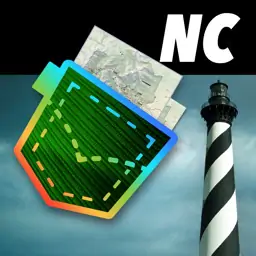Tear SheetPocosin Lakes |
Tear Sheet of Pocosin Lakes National Wildlife Refuge (NWR) in North Carolina. Published by the U.S. Fish & Wildlife Service (USFWS).
featured in
| North Carolina Pocket Maps |  |
U.S. Fish and Wildlife Service
Pocosin Lakes National Wildlife Refuge
Welcome to Pocosin Lakes National Wildlife Refuge. The
refuge is located in northeastern North Carolina, and
stretches through Hyde, Tyrrell, and Washington Counties.
Today Pocosin Lakes Refuge encompasses 110,106 acres
which are used to provide habitat for migratory waterfowl,
other migratory birds, and threatened and endangered
species, to protect and enhance the pocosin habitat, and to
provide opportunities for wildlife interpretation, outdoor
recreation and environmental education. The designated
wildlife observation areas and trails offer the best wildlife
viewing opportunities for many species of wildlife. Pocosin
Lakes Refuge is one of more than 540 National Wildlife
Refuges that protect over 100 million acres throughout the
United States. Come and enjoy the natural beauty on your
National Wildlife Refuge!
Habitat & History
The term pocosin is an Algonquian Indian word meaning
“swamp on a hill.” These pocosin wetlands, also called
southeastern shrub bogs, are at a slightly higher elevation
than the surrounding landscape and have deep organic soils
called peat. The organic soil is made up of leaves, sticks,
and other organic matter that accumulates and decomposes
slowly over time. The peat soil acts as a sponge, holding
water at these higher elevations and releasing it very slowlythus creating a swamp on a hill. Once lost, it can take over
100 years to create approximately one inch of peat soil. The
pocosin is a fire adapted ecosystem. Many of the plant species
that occur in pocosins require fire to release new seeds and
provide conditions to allow new growth.
Pocosin Lakes Refuge was established in 1990 when The
Conservation Fund in conjunction with the Richard King
Mellon Foundation donated over 93,000 acres to the U.S.
Fish & Wildlife Service. The adjacent 12,000 acre Pungo
Refuge, established in 1963 to serve as an inviolate waterfowl
sanctuary, was combined with these new refuge lands and
became the Pungo Unit of Pocosin Lakes Refuge. Prior to
becoming a wildlife refuge, thousands of acres of pocosin
wetlands were severely degraded by an extensive canal and
ditch system that was used to drain these wetlands for timber
harvest, agriculture, pasture and peat mining. Draining
the lands also dried out the peat soils making the lands
much more susceptible to catastrophic wildfires and ground
fire. Since 1990, the refuge has been restoring the natural
hydrology to make the pocosins wet again. This will provide a
healthy, functioning wetland; improving wildlife habitat, water
quality, and sequestering (i.e., storing) tons of carbon and
nitrogen that would have been released into the atmosphere
and waterways.
Refuge Management
The refuge staff works to provide high quality habitat
conditions for a variety of wildlife. Habitat management
actions include cooperative farming, moist soil management,
invasive species management, hydrology restoration,
prescribed burning, water management and wildfire
protection and suppression.
Wildlife
More than 300 different wildlife species, including the
endangered red wolf and red-cockaded woodpecker, inhabit the
refuge. During the winter months on the Pungo Unit, visitors
can observe tens of thousands of tundra swans, snow geese,
Canada geese and a variety of duck species. Numerous wading
birds, shore birds, Neotropical migratory song birds and birds
of prey (including the bald eagle) utilize the refuge. Abundant
black bears and deer are easily observed roaming and foraging
on the refuge. Other species including river otters, bobcats,
foxes, five-lined skinks, green tree frogs, yellow- bellied sliders,
canebrake rattlesnakes and other reptiles and amphibians can
also be found on Pocosin Lakes Refuge. Please see the refuge’s
wildlife list for more information.
Things to Do
Wildlife observation and wildlife photography
Hunting and fishing (please see our annual hunting and fishing
brochure for more information)
Environmental education and interpretation (you can find
more information on these opportunities at our Visitor Center
in Columbia, NC)
Regulations
n The refuge is open for “Daylight Use Only” (30 minutes
before sunrise to 30 minutes after sunset).
n Refuge Roads open to vehicles are for licensed vehicles
only; state and federal traffic regulations apply.
n Please abide by all refuge regulatory signs.
n Prohibited activities include: littering, fires, cutting and/or
removing vegetation, taking or collecting plants, animals,
flowers, nuts, berries, or any other items, baiting or feeding
wildlife, riding all terrain vehicles (ATV’s) except as
provided for in our hunting regulations, and all commercial
activities
n Unless otherwise posted, the speed limit on all refuge roads
is 25 mph.
n Please use good judgment and caution when driving on any
refuge road. Road surface conditions vary greatly due to
weather conditions and some unimproved (dirt) roads may
become impassible at times.
Safety
n Biting insects and ticks are numerous along trails during
summer months. Use of insect repellant is advised.
n Many black bears roam throughout the refuge. If you
encounter a bear, never run. Instead of running, let the
bear know you are there by backing up slowly while waving
your arms above your head and speaking loudly.
n Tell a friend or relative where you are going and when to
expect your return.
Pungo Unit of
Pocosin Lakes
U.S. Fish and Wildlife Service
photo: Mike Dunn
photo: Mike Dunn
For more information please contact:
Refuge Manager
Pocosin Lakes National Wildlife Refuge
P.O. Box 329, 205 South Ludington Drive
Columbia, North Carolina 27925
252/796 3004
Fax: 252/796 3010
pocosinlakes@fws.gov
http://www.fws.gov/pocosinlakes/

